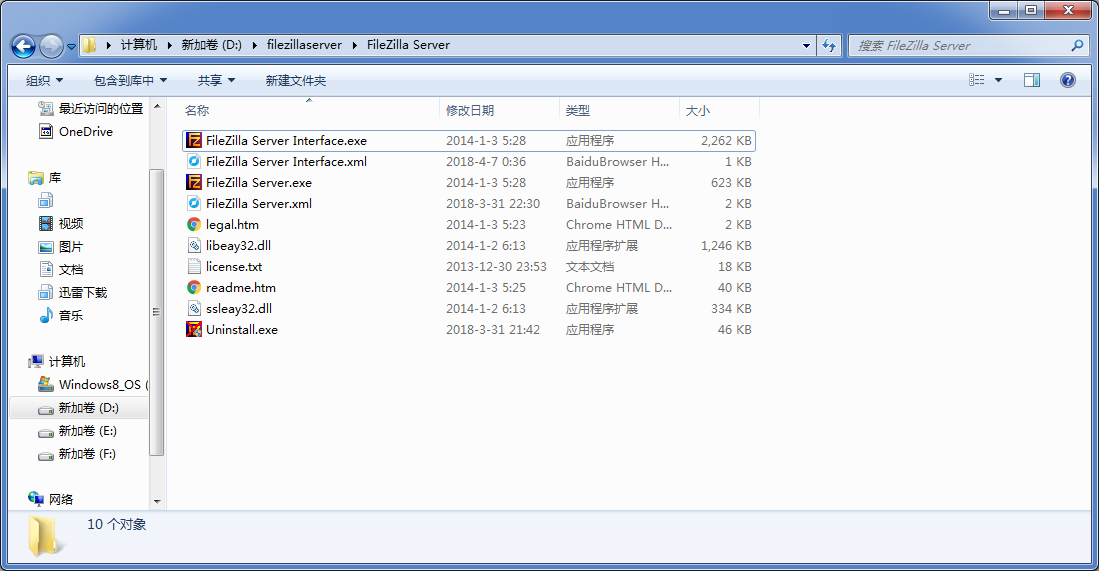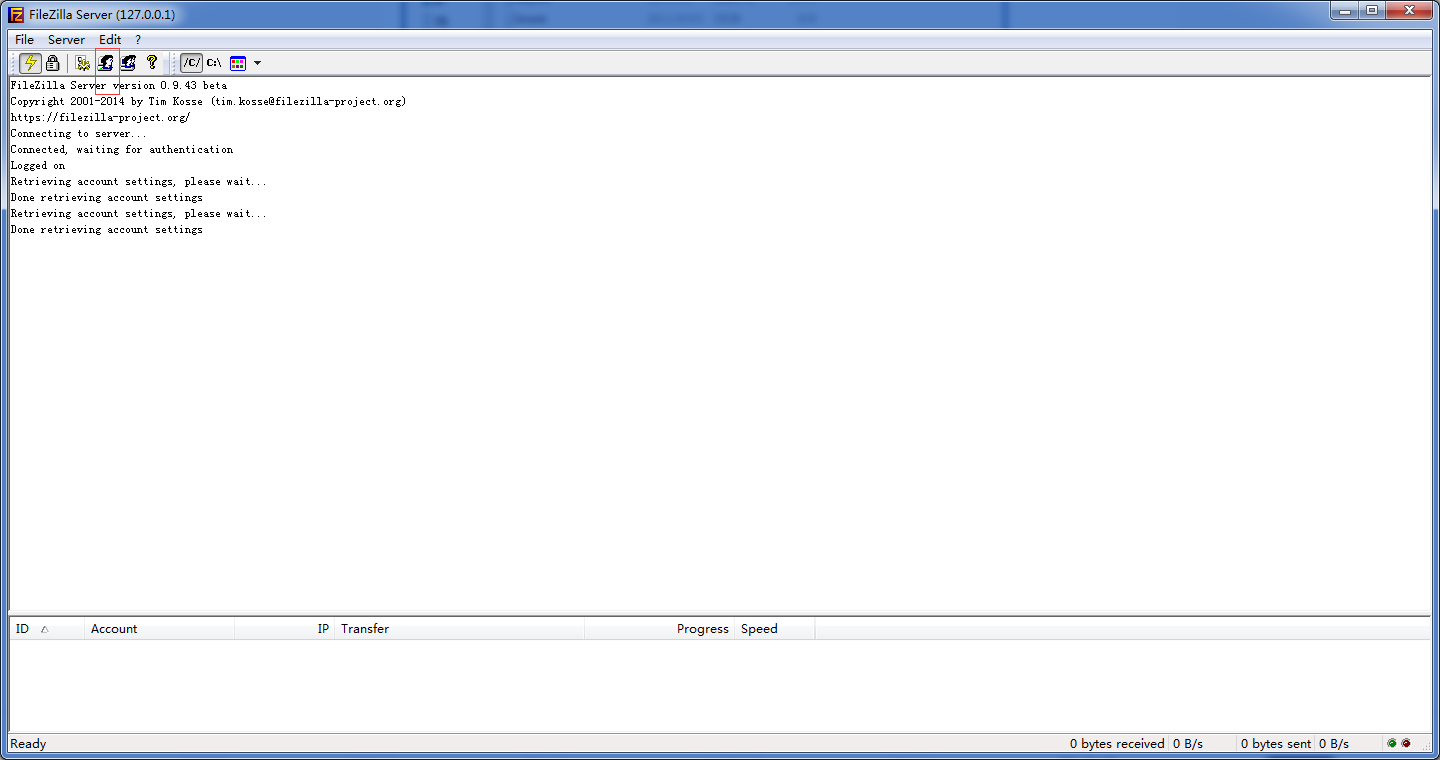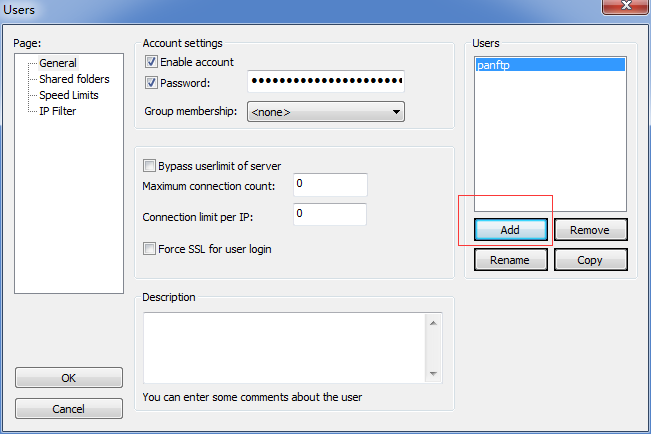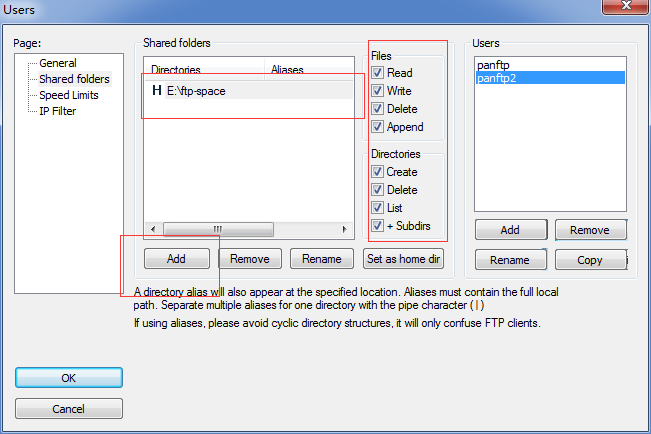项目中经常需要使用到文件的上传下载,这里介绍一下以filezilla作为文件服务器时,文件的上传和下载,虽然是使用filezilla作为ftp服务器,但是如果换为其他服务器代码是一样可以使用的。
首先下载filezilla,地址:https://sourceforge.net/projects/filezilla/files/?source=navbar
选择filezilla server下载,安装好以后,打开安装路径文件夹如下:

注意用管理员打开filezilla server后,然后点开filezilla server Interface,然后可以看到如下界面:

点击红框中的按钮,可以配置连接服务端的用户和权限,如下图所示:

点击add添加账号,输入账号名字点击ok,然后如下图

注先点击红框中的add添加主文件夹,然后右边的files下面的几个框代表文件的操作权限,directories代表文件夹的操作权限。设置好以后点击ok然后设置密码之后就完事了。
接着是项目中的使用。
首先pom文件中要有以下的包:
<!-- 封装了各种网络协议的客户端,支持FTP、NNTP、SMTP、POP3、Telnet等协议 -->
<dependency>
<groupId>commons-net</groupId>
<artifactId>commons-net</artifactId>
<version>3.1</version>
</dependency>
<!-- java上传文件 -->
<dependency>
<groupId>commons-fileupload</groupId>
<artifactId>commons-fileupload</artifactId>
<version>1.2</version>
</dependency>接着配置一个文件解析器:
<!-- 配置一个文件上传解析器,此ID是固定的,无法改变的 -->
<bean id="multipartResolver" class="org.springframework.web.multipart.commons.CommonsMultipartResolver">
<!-- 单位是byte,例如:10M=10*1024*1024 当设值为:-1时表示不限制容量 -->
<property name="maxUploadSize" value="-1"></property>
<!-- 默认字符集编码 -->
<property name="defaultEncoding" value="UTF-8"></property>
<!-- 每次读取文件时,最大的内存容量 -->
<property name="maxInMemorySize" value="1024"></property>
</bean>然后是ftp的工具类:
/**
*
*@description
*@auth panmingshuai
*@time 2018年4月1日上午1:11:27
*
*/
public class FtpKit {
// ftp服务器地址
public static String hostname = "127.0.0.1";
// ftp服务器端口号默认为21
public static Integer port = 21;
// ftp登录账号
public static String username = "panftp";
// ftp登录密码
public static String password = "123456";
public static FTPClient ftpClient = null;
/**
* 初始化ftp服务器
*/
public static void initFtpClient() {
ftpClient = new FTPClient();
ftpClient.setControlEncoding("utf-8");
try {
ftpClient.connect(hostname, port); // 连接ftp服务器
ftpClient.login(username, password); // 登录ftp服务器
int replyCode = ftpClient.getReplyCode(); // 是否成功登录服务器
if (!FTPReply.isPositiveCompletion(replyCode)) {
System.out.println("connect failed...ftp服务器:" + hostname + ":" + port);
}
System.out.println("connect successfu...ftp服务器:" + hostname + ":" + port);
} catch (IOException e) {
e.printStackTrace();
}
}
/**
* 上传文件
*
* @param pathname ftp服务保存地址
* @param fileName 上传到ftp的文件名
* @param inputStream 输入文件流
* @return
*/
public static boolean uploadFile(String pathname, String fileName, InputStream inputStream) {
try {
initFtpClient();
ftpClient.setFileType(FTP.BINARY_FILE_TYPE);
ftpClient.makeDirectory(pathname);
ftpClient.changeWorkingDirectory(pathname);
ftpClient.storeFile(fileName, inputStream);
inputStream.close();
ftpClient.logout();
ftpClient.disconnect();
return true;
} catch (Exception e) {
e.printStackTrace();
}
return false;
}
public static boolean existFile(String path) throws IOException {
initFtpClient();
FTPFile[] ftpFileArr = ftpClient.listFiles(path);
if (ftpFileArr.length > 0) {
return true;
}
return false;
}
/**
* 下载文件
*
* @param pathname FTP服务器保存目录 *
* @param filename 要删除的文件名称 *
* @return
*/
public static byte[] downloadFile(String pathname, String filename) {
try {
initFtpClient();
ftpClient.changeWorkingDirectory(pathname);
FTPFile[] ftpFiles = ftpClient.listFiles();
for (FTPFile file : ftpFiles) {
if (filename.equalsIgnoreCase(file.getName())) {
return IOUtils.toByteArray(ftpClient.retrieveFileStream(file.getName()));
}
}
ftpClient.logout();
ftpClient.disconnect();
} catch (Exception e) {
e.printStackTrace();
}
return null;
}
/**
* 删除文件
*
* @param pathname FTP服务器保存目录 *
* @param filename 要删除的文件名称 *
* @return
*/
public static boolean deleteFile(String pathname, String filename) {
try {
initFtpClient();
ftpClient.changeWorkingDirectory(pathname);
ftpClient.dele(filename);
ftpClient.logout();
ftpClient.disconnect();
return true;
} catch (Exception e) {
e.printStackTrace();
}
return false;
}
}然后是controller:
/**
*
*@description
*@auth panmingshuai
*@time 2018年4月1日上午1:11:27
*
*/
@Controller
@RequestMapping("test")
public class TestController {
/**
* 上传文件
* @param file
* @return
* @throws IOException
*/
@RequestMapping("/upload")
@ResponseBody
public ReturnModel upload(MultipartFile file) throws IOException {
if (file != null) {
String suffix = file.getOriginalFilename().substring(file.getOriginalFilename().lastIndexOf("."));
String fileName = UUID.randomUUID().toString() + suffix;
//指定上传的文件要放到data文件夹下,fileName是存放文件的名字
FtpKit.uploadFile("data", fileName, file.getInputStream());
return new ReturnModel(ReturnModel.SUCCESS_CODE, "上传成功");
}
return new ReturnModel(ReturnModel.SUCCESS_CODE, "上传失败");
}
/**
* 下载
* @param fileId
* @param response
* @throws IOException
*/
@RequestMapping(value = "/download")
public void downPhotoByStudentId(String fileId, final HttpServletResponse response) throws IOException{
response.reset();
response.setHeader("Content-Disposition", "attachment; filename=\"" + fileId + "\""); //设置文件名
response.addHeader("Content-Length", "" + "879394"); //设置文件大小,以B为单位
response.setContentType("application/octet-stream;charset=UTF-8");
OutputStream outputStream = new BufferedOutputStream(response.getOutputStream());
//指明要从哪个文件夹下寻找文件
outputStream.write(FtpKit.downloadFile("data", fileId));
outputStream.flush();
outputStream.close();
}
}完毕。